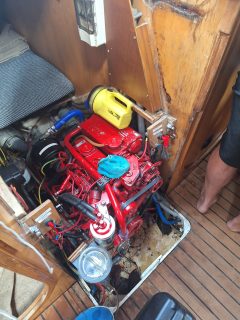Black Slugs in My Diesel Tank
The Breakdown
During a recent club cruise to the Butt & Oyster, I was night sailing off Holland-on-Sea when Blue Streak’s engine suddenly cut out. While there was some wind, it wasn’t enough to make comfortable headway. Janet and Nic kept us moving slowly under sail while I headed below to diagnose the issue. It quickly became clear that no fuel was reaching the engine.
When the weather calmed a little, I topped up the tank and tried bleeding the fuel system—but still, no joy. I suspected a blockage in the fuel line. Despite always using anti-diesel bug additive, I assumed the culprit might be diesel bug.

Improvising a temporary solution, I grabbed a length of plastic tubing, a can of clean diesel, and—don’t laugh—one of my good Disney socks, which I used to help secure the line inside the can. This makeshift gravity feed got us going again, although every so often, the line would suck air and the engine would stop.
Eventually, Janet, who had been up longest, turned in, leaving Nic and me to sail Blue Streak into Hamford Water. We dropped anchor at 05:00 hrs and finally got some sleep.
Finding the Problem

The next day, after a flurry of messages on WhatsApp, a full team turned up with tools: Green Flag (Lee), AA (Paul), and RAC (John). Paul had a small tyre compressor, which we connected to the engine end of the fuel line. When we switched it on, the pressure built up until—bang!—we heard a noise from the fuel tank, followed by bubbles… and then diesel began flowing freely again. Problem solved? Not quite. Whatever had blocked the line was still in the tank. Transferring the Fuel Paul brought more fuel line, and I had an electric lube oil pump on board. Between
John, Paul, and myself, we rigged a basic diesel transfer system. John began removing the inspection cover on the tank, which had been sealed down with black mastic. After a bit of persuasion, he got the lid off. Our expert fuel team — Lee, Janet, and Nic- pumped out, cleaned, and transferred diesel into clean cans.
Finding the Culprits
pieces of black mastic. Not just a few—loads of them. There were also other mastic fragments
floating about. Thankfully, there was no sign of diesel bug.
courtesy of Lee.
One More Issue…
With the tank refilled and a final electrical issue on the fuel gauge corrected by Janet, we cleaned up
and got back underway toward Pin Mill.
In Conclusion
- The previous owner likely thought they were doing the right thing by using lots of sealant to prevent leaks, but instead created a hidden hazard.
- Always carry spare parts and basic materials for emergency repairs.
- Sail in company when you can—it makes all the difference.
- A club full of members with varied skills is an invaluable resource.
- A solid working knowledge of diesel engines is essential. (The RYA Diesel Engine course is
highly recommended!)
